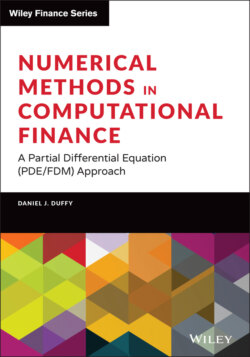Читать книгу Numerical Methods in Computational Finance - Daniel J. Duffy - Страница 31
1.6.3 Lipschitz Continuous Functions
ОглавлениеWe now examine functions that map one metric space into another one. In particular, we discuss the concepts of continuity and Lipschitz continuity.
It is convenient to discuss these concepts in the context of metric spaces.
Definition 1.7 Let and be two metric spaces. A function f from X into Y is said to be continuous at the point if for each there exists a such that:
This is a generalisation of the concept of continuity in Section 1.2 (Definition 1.1). We should note that this definition refers to the continuity of a function at a single point. Thus, a function can be continuous at some points and discontinuous at other points.
Definition 1.8 A function f from a metric space into a metric space is said to be a uniformly continuous on a set if for each there exists a such that:
If the function f is uniformly continuous, then it is continuous, but the converse is not necessarily true. Uniform continuity holds for all points in the set E, whereas normal continuity is only defined at a single point.
Definition 1.9 Let be a real-valued function and suppose that we can find two constants M and such that . Then we say that f satisfies a Lipschitz condition of order , and we write .
We take an example. Let on the interval [a, b].
Then:
Hence .
A concept related to Lipschitz continuity is called a contraction.
Definition 1.10 Let and be metric spaces. A transformation T from X into Y is called a contraction if there exists a number such that:
In general, a contraction maps a pair of points into another pair of points that are closer together. A contraction is always continuous.
The ability to discover and apply contraction mappings has considerable theoretical and numerical value. For example, it is possible to prove that stochastic differential equations (SDEs) have unique solutions by the application of fixed point theorems:
Brouwer's fixed point theorem
Kakutani's fixed point theorem
Banach's fixed point theorem
Schauder's fixed point theorem
Our interest here lies in the following fixed point theorem.
Theorem 1.2 (Banach Fixed Point Theorem) Let T be a contraction of a complete metric space (X, d) into itself:
Then T has a unique fixed-point . Moreover, if is any point in X and the sequence is defined recursively by the formula , then and:
In general, we assume that X is a Banach space and that T is a linear or non-linear mapping of X into itself. We then say that x is a fixed point of T if .
